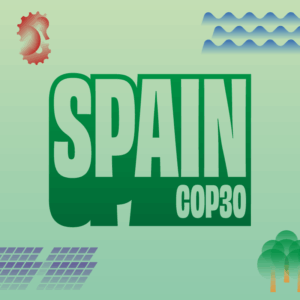- Nearly 900 attendees at the events organised in the Pavilion and 22,000 streaming views show that this space has already become a place of reference for discussing the main themes that are the focus of these summits
- 220 entities representing the government, private or academic sectors have participated in the 47 events held during the Baku Climate Summit
- 270 speakers and moderators have passed through the Spanish Pavilion, which has had 51% of women participants
For the third consecutive year, the Government of Spain, under the coordination of the Ministry for the Ecological Transition and the Demographic Challenge (MITECO), has promoted the participation of national and international entities in the Spanish Pavilion at COP29, which concludes its activity with data, once again, very relevant that demonstrate the great interest generated by the 47 events organized and the quality of the speakers and moderators who have participated. During the nine days of activity, 860 attendees, 292 speakers and moderators and 220 entities from various sectors have passed through the pavilion. Thus, 33.4% of participating entities came from the government, 16.5% from the private sector, 16.2% from civil society and NGOs, 11.6% from academia and research and another 2.8% were young people. Other types of actors have made up the remaining 2.5% of the participants. In addition, 32.2% of the entities represented in the pavilion were Spanish and 67.8% were international entities. Another of the pavilion’s objectives was to promote gender equality among the participants, something that has been achieved thanks to the 51% of women participating in the different high-level panels. As was the case at COP28 held in Dubai, 100% of the events have been streamed through the social media channels of the MITECO Biodiversity Foundation, achieving nearly 22,000 views, with an average follow-up of about 500 views per event. In total, during the nearly 50 hours live, about 13,000 people have connected to follow the activity of the pavilion through X (former Twitter). Another 7,600 have followed the events through the Linkedin profile and more than 1,300 have done so on Youtube. These data reinforce the objectives that were intended to be achieved this year with the Spanish Pavilion, designed to provide answers and show solutions and commitments, and which has once again become a key meeting point for actors and institutions of great relevance at the national and international level in the field of climate change.
INTERNATIONAL VISION
Governments, companies, young people and international organisations have had their space to have a complete vision of the solutions we need to face the challenges generated by the climate crisis. A large part of the panels have had a markedly international character, achieving the participation of many countries and sectors to share the cross-cutting and shared remains of the climate agenda. Almost 220 national and international organisations have passed through the Spanish pavilion. Among the participants are representatives of governments and multilateral organizations such as UN Women, FAO, UNECE, UNESCO, UNICEF, UNCCD, the World Meteorological Organization, or the UNFCCC itself. At the governmental level, representatives of the governments of Brazil, Madagascar, Finland, Portugal, Argentina, Uganda, Colombia, Peru, Uzbekistan, the United Arab Emirates, the United States and Guatemala were present, including, for example, former prime ministers such as Carlos Alvarado of Costa Rica, or the Minister of the Environment, Climate Action, Communications and Transport of Ireland, the Secretary of State of Portugal or the Undersecretary of Development of Finland. Representatives of the European Union have also passed through the Spanish pavilion such as the deputy director general. the European Commission’s Directorate-General for Climate, representatives of subnational governments such as the city of Turku or representatives of the city council of Valladolid, the Regional Government of Andalusia, the Barcelona Provincial Council and the government of the Canary Islands. The Spanish business sector has also had a special presence in the programmed activities, as well as civil society and academic entities such as BC3, CREAF, the University of Venice, the Helmholtz centre, Oxford or the IPCC. The Pavilion ended its activity yesterday with the presence of the Youth Champion, Leyla Hasanova, thinking about the Future Pact on how to include young people in relevant decision-making for future generations, where a group of young people from different countries emphasized the urgency of action and creating space for young people in decision-making at climate summits.









